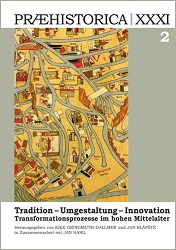Archäologische Funde landwirtschaftlicher Geräte – zwischen Tradition und Innovation. Eine Fallstudie anhand der Bodenbearbeitungsgeräte
Archeological Findings of Agricultural Implements – Between Tradition and Innovation. The Case Study on Basis of Cultivation Implements
Author(s): Karoline MüllerSubject(s): Archaeology, Agriculture, Economic history, Middle Ages, Economic development
Published by: Univerzita Karlova v Praze, Nakladatelství Karolinum
Keywords: Middle Ages; north-western Germany; the Netherlands; farming tools; plough; coulter; spade; tracks oft he plough;
Summary/Abstract: In this article an overview of Middle Age ground cultivation equipment in Holland and North West Germany will be provided. In the following, traditional aspects, as well as the inherent potential of innovation of these agricultural tools, will be discussed. In addition to the published spade, hook, ploughshare and coulter findings, dating back to the time between the 5th and the 15th century AD, hook and plough traces also will be described and evaluated. Despite having to rely on a small source basis for interpretation (there are just 57 findings of artifacts and 25 archeological features that could be analysed), the materials nevertheless open themselves up for interesting enquiries and interpretations. This can be seen very clearly in the case of the spade findings. In each single one of the 18 findings of spades, function- related and thus longlasting traditional form as well as remodelling and innovation of design are of equal importance. The optimal traditional shape of spades will be (innovatively?) modified. Also the 34 hook and ploughshares, combined with the discovered features presented here, show elements of not only tradition but also of innovation. In symmetrical shares both, traditional regional and supraregional forms appear to have originated. But since these cannot be linked to any specific ground or sowing techniques, it is not possible to associate them to intentionally expanded purposes of usage. The innovative idea of turning the clods of earth with ploughs with asymmetrical ploughshares is well known. However the large breakthrough only happened in the High Middle Ages when the working process was combined with horses as drought animals to pull the ploughs, using breastplates and collars.
Journal: Praehistorica
- Issue Year: 31/2013
- Issue No: 2
- Page Range: 613-633
- Page Count: 21
- Language: German

